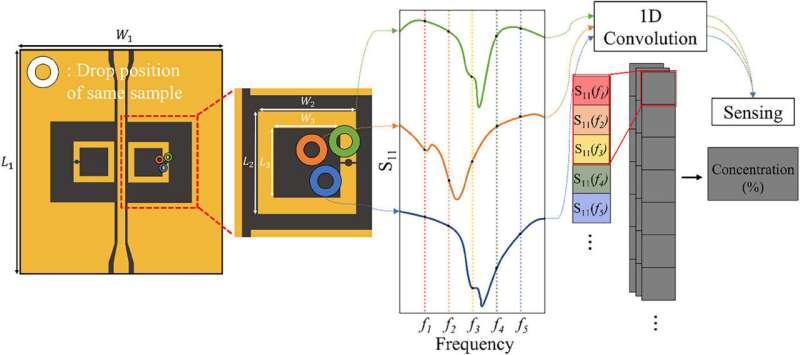
A collaborative research team has recently developed a new method for measuring glucose using deep learning technology. Their research was published in Laser & Photonics Reviews.
Metamaterials are artificial materials with unique electromagnetic properties not found in nature, enabling them to manipulate electromagnetic waves such as light or microwaves. A common structure used in the design of metamaterials is the split ring resonator (SRR) which features a ring with a split in its center. This design allows the SRR to absorb, penetrate, or reflect electromagnetic fields at specific frequencies and amplify signals due to the interruption of smooth current flow, leading to electromagnetic resonance within the ring.
While SRRs have been widely used in sensors, their effectiveness has been limited by inconsistent and unreliable measurements influenced by factors such as temperature, humidity, and sample location.
In this study, the team aimed to address the issue of SRR-based sensor electrical signal fluctuations caused by changes in sample position. They began by optimizing the sensor to amplify electrical signals in the 0.5 to 18 GHz frequency range using a photolithography process that creates patterns on semiconductors with light. The researchers then employed deep learning technology to enable the glucose sensors to learn from the electrical signals measured at various locations.
Building on this foundation, the team developed a one-dimensional convolutional neural network (1D CNN) and conducted experiments with it. The results demonstrated that the model effectively compensated for errors due to sample location variations, achieving a mean absolute error (MAE) of 0.695% and a mean squared error (MSE) of 0.876%.
The team consisted of Professor Junsuk Rho from the Department of Mechanical Engineering, the Department of Chemical Engineering, and the Department of Electrical Engineering and Ph.D. candidates Seokho Lee and Kyungtae Kim from the Department of Mechanical Engineering at Pohang University of Science and Technology (POSTECH), and Professor Hee-Jo Lee from Daegu University’s Department of Physics Education.
Professor Rho of POSTECH stated, “We have successfully managed to control the electrical signal which is sensitive to changes in sample position, thus enhancing the consistency and reliability of the glucose measurement device.”
“It is also noteworthy that this technology can be commercialized and mass-produced using a photolithography process which is already widely employed in the semiconductor industry.”
More information:
Seokho Lee et al, Deep Learning‐Driven Robust Glucose Sensing and Fruit Brix Estimation Using a Single Microwave Split Ring Resonator, Laser & Photonics Reviews (2024). DOI: 10.1002/lpor.202300768
Citation:
Making glucose measurement in food easier with deep learning (2024, July 2)
retrieved 2 July 2024
from https://phys.org/news/2024-07-glucose-food-easier-deep.html
This document is subject to copyright. Apart from any fair dealing for the purpose of private study or research, no
part may be reproduced without the written permission. The content is provided for information purposes only.







